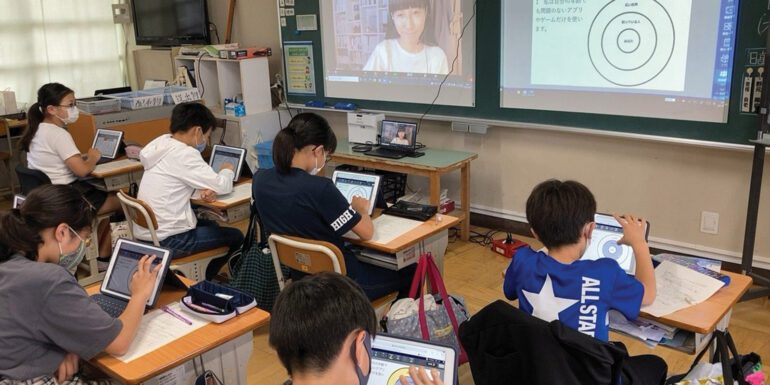TL;DR:
- Japanese education ministry releases guidelines emphasizing AI comprehension for students.
- Guidelines focus on understanding AI characteristics, advantages, and disadvantages.
- Students warned against the inappropriate use of AI-generated content as their own.
- AI integration promoted in English learning and group activities to enhance discussions.
- Teachers are encouraged to improve AI literacy and use AI tools to streamline tasks.
- Guidelines address personal information leakage concerns and urge caution.
- Government requests AI companies to enhance products for educational use.
- Collaboration with NHK to produce educational videos on generative AI learning.
- Guidelines to be implemented in public schools and other educational institutions.
Main AI News:
In an effort to equip students with essential skills for the digital age, the Japanese education ministry has unveiled comprehensive guidelines emphasizing the significance of understanding artificial intelligence (AI). Released on Tuesday, these guidelines outline how generative AI can be seamlessly integrated into school curricula while addressing potential risks and necessary precautions.
The guidelines stress the need for students to comprehend the characteristics of AI, including its advantages and disadvantages. Students are encouraged to be aware of potential risks, such as personal information leakages and copyright infringement, before utilizing AI. Notably, the guidelines explicitly state that it is inappropriate for students to pass off reports, essays, or any other works produced by AI as their own.
Moreover, the guidelines advocate for the integration of AI in English learning and the incorporation of AI tools in group activities. This approach allows students to explore and address diverse perspectives, thereby enhancing the depth of discussions. Education minister Keiko Nagaoka expressed commitment to addressing concerns, improving teachers’ understanding and skills, and fostering a safe and effective environment for AI utilization in education.
The guidelines will be distributed to boards of education and other organizations, facilitating widespread implementation and adoption. Hisanobu Muto, a school digitization project team leader at the ministry, emphasized the importance of experimental activities based on the guidelines, taking into consideration personal data protection, security, and copyright. These activities will yield valuable outcomes, contributing to further discussions and advancements in the future.
Recognizing the significance of AI literacy among teachers, the guidelines encourage educators to use AI-generated fake information as teaching materials. This approach enables students to learn the critical skill of fact-checking. Additionally, the guidelines promote the use of AI tools to streamline administrative tasks, reduce teachers’ workloads, and enhance their teaching practices. As part of this transformation, traditional exam and homework methods that can be easily automated using AI may need to be discarded.
Muto emphasized the importance of teachers familiarizing themselves with new technology and utilizing it in a convenient, safe, and smart manner. Improving teachers’ AI literacy and promoting working style reform through comprehensive teacher training and the appropriate use of information in public service are key priorities, he added.
The guidelines also address concerns regarding personal information leakage. They advise against inputting sensitive information into AI systems and recommend implementing safeguards to prevent the use of such information for machine learning purposes.
To ensure AI products are suitable for educational use in Japan, the government plans to request AI companies to improve their offerings. This includes strengthening content filtering mechanisms to mitigate harmful content, implementing personal information protection features, and developing AI tools specifically designed for educational contexts.
In collaboration with NHK, the Japanese ministry intends to produce educational videos on generative AI learning, as outlined in the guidelines. These resources aim to enhance understanding and facilitate effective implementation of AI technologies in various educational institutions, not limited to public schools.
The ministry clarified that the guidelines are still in the tentative phase and will be continuously updated based on feedback and the development of additional regulations pertaining to AI technology.
A recent survey conducted by CyberOwl, a Tokyo-based organization specializing in online media related to education, revealed that approximately 70% of 508 parents of students ranging from third grade to high school believe regulations for the use of AI chatbots, such as ChatGPT, by children are necessary. Among the respondents, 49% expressed relative anxiety, while approximately 15% reported being anxious. Concerns about the decrease in critical thinking ability were raised by 35% of parents, with 34% expressing worries about their children believing false information.
Notably, the survey results indicate a significant difference in anxiety levels between parents who have used ChatGPT and those who have not. While approximately 44% of parents who have used ChatGPT expressed concerns about its use by children, this figure rose to 72.9% for parents who have not utilized the technology.
Tatsuya Horita, a professor of information and technology at Tohoku University, emphasized the accessibility of generative AI on smartphones and computers. He believes that teachers and parents should have firsthand experience using AI technologies. Rather than harboring vague concerns about the unknown, Horita emphasizes the importance of educating individuals on the mechanisms of AI and its appropriate use.
Conclusion:
The introduction of Japan’s new school guidelines that prioritize AI comprehension signifies the country’s commitment to preparing students for the digital era. By emphasizing the understanding of AI characteristics and promoting responsible usage, these guidelines seek to equip students with the necessary knowledge and skills. The integration of AI in English learning and group activities fosters a deeper understanding of different perspectives.
Moreover, the focus on improving AI literacy among teachers and streamlining administrative tasks through AI tools reflects an effort to enhance the education system’s efficiency. The guidelines also address concerns related to personal information leakage and advocate for the development of AI products tailored to educational use. This proactive approach positions Japan as a leader in leveraging AI for educational purposes, creating opportunities for AI companies to enhance their offerings in the Japanese market.

